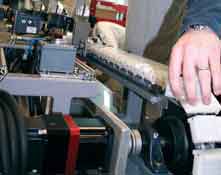When US-based Armor Holdings needed some help with the production of a machine to produce specialised kits for drug detection, it turned to students at the University of North Florida for help.
The result is the Narcotics Identification Kits Machine (NIK), a system that automates the production of the kits which are used by law enforcement officers worldwide.
The kits themselves are composed of up to three chemical-filled glass tubes encased in plastic sleeves and inserted into zip-lock bags. Officers needing to identify suspicious substances break a cylinder, pour the substance into the plastic bag and await a chemical reaction. Once the liquid changes colour, the officers consult a drug-identification chart to determine the substance.
'Production of this kit is a high-volume, labour-intensive, monotonous task, and it's hazardous due to chemicals in the ampules, which sometimes break in production,' said Dr. Dan Cox, UNF mechanical engineering professor and project adviser.
To reduce hazards and increase production, Armor Holdings challenged the students to design a machine that will produce one kit every three seconds. The students then went out and built the NIK Machine and Armor Holdings picked up the $40,000 tab!
'The students designed custom parts, welded the frame, did the wiring and designed and built the controller console and feeder bowl,' Cox said.
The students are now testing the machine to produce one kit every two seconds. Once the machine is complete, Armor Holdings has exclusive rights to it, with UNF receiving royalties.

'We don't have the mechanical engineering expertise that's necessary to complete a project like this, which is one reason we were interested in working with UNF,' said Bryan Smith, Armor Holdings' plant manager. 'Another good thing about working with students is that they're more open-minded and eager to try new things than engineers who have years of experience.'
Smith said the students have made great progress, adjusting and redesigning the machine several times along the way. 'We went through three or four different mechanical designs and finalised on this one, which seems to fit the bill,' he said.




Swiss geoengineering start-up targets methane removal
No mention whatsoever about the effect of increased methane levels/iron chloride in the ocean on the pH and chemical properties of the ocean - are we...